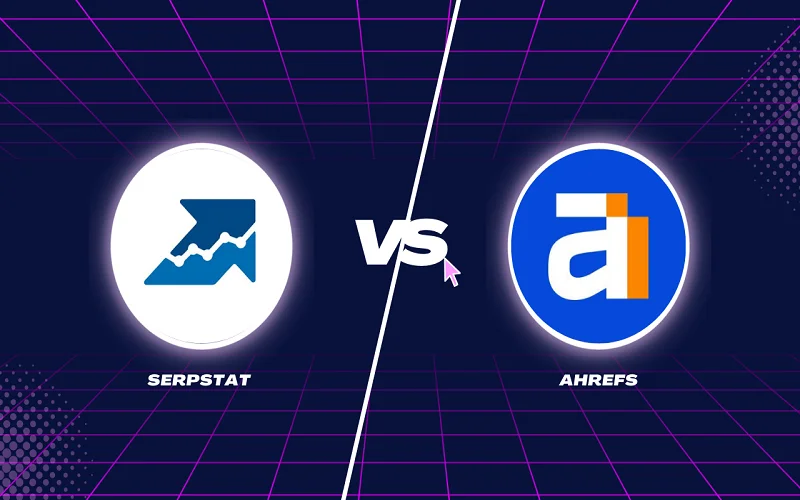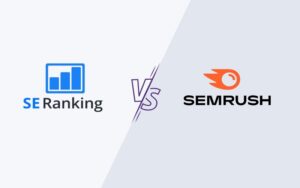“Serpstat vs Ahrefs” – a comparison that many SEO professionals and digital marketers ponder over. In this comprehensive blog post, we delve into the strengths and nuances of both Serpstat and Ahrefs, two of the leading tools in the SEO and digital marketing space. This comparison aims to provide insights into their functionalities, from keyword research capabilities to site audit features. Whether you’re just starting in the world of SEO or are a seasoned expert, understanding the key differences between these tools can significantly influence your online strategy and decision-making process. Join us as we explore each tool’s offerings, helping you decide which is the best fit for your SEO and digital marketing goals.
Table of Contents
Ease of Use and User Interface
When comparing Serpstat and Ahrefs, a key aspect to consider is the ease of use and user interface, as it significantly impacts the overall user experience. Here, we dive into how both tools fare in this domain, keeping in mind our focus keyword: “Serpstat vs Ahrefs.”
Serpstat
Serpstat greets its users with a clean and intuitive interface. The dashboard is neatly organized, making it relatively easy for beginners to navigate through its features. One of the standout aspects of Serpstat is its minimalistic design, which doesn’t overwhelm users with too much information at once. This approach is particularly beneficial for those new to SEO tools, as it allows for a smoother learning curve.
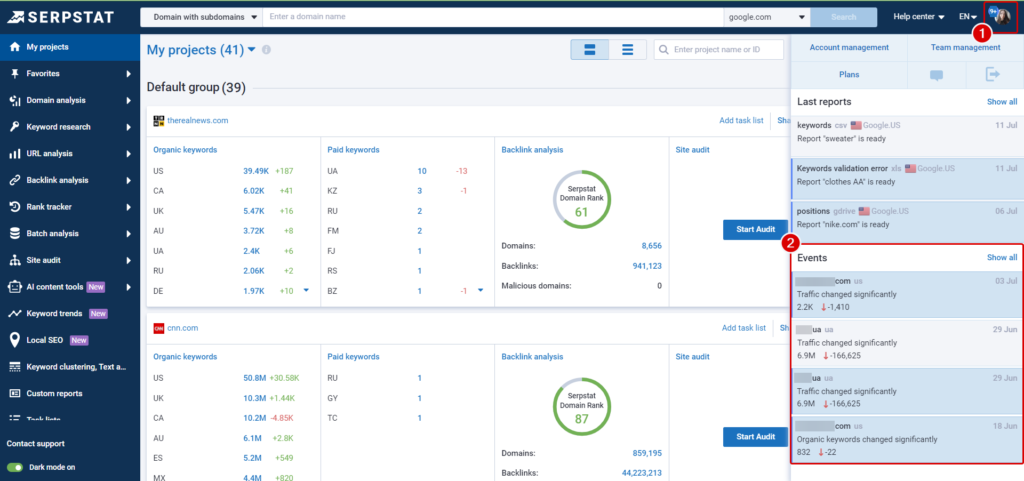
Ahrefs
Ahrefs, on the other hand, offers a more feature-rich interface. It’s packed with detailed data and numerous functionalities right from the home screen. While this is immensely valuable for seasoned SEO professionals, it might come across as slightly overwhelming for beginners. However, Ahrefs does an excellent job in terms of organizing its vast array of features, ensuring that users can still find what they need without too much hassle.
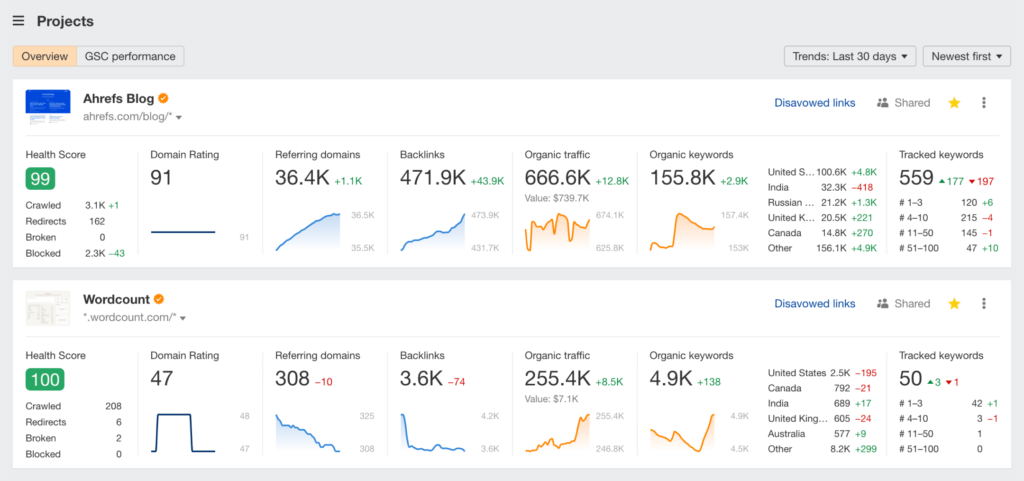
Comparing the Two
In the “Serpstat vs Ahrefs” debate regarding ease of use and user interface, it boils down to user preference and experience level. Serpstat wins points for its simplicity and user-friendly approach, ideal for those who prefer a straightforward, clutter-free experience. Ahrefs, while initially daunting, is a powerhouse of features that, once mastered, offers unparalleled depth in data and analysis tools.
Both platforms have made strides in ensuring that their interfaces are not just about aesthetic appeal but also about functional design. They provide tool-tips, guides, and support to help users navigate through their offerings.
In conclusion, while both Serpstat and Ahrefs have their unique strengths in terms of user interface and ease of use, the choice largely depends on the user’s proficiency and specific needs in SEO and digital marketing.
Keyword Research Capabilities
In the world of SEO tools, keyword research is a crucial function, and when comparing Serpstat vs Ahrefs, it’s important to understand how each tool stands out in this regard.
Serpstat
Serpstat offers a robust keyword research tool that is both comprehensive and user-friendly. It provides valuable insights into keyword trends, search volume, competition level, and cost-per-click (CPC) data. One of Serpstat’s unique features is its ability to identify keyword trends over time, giving users a broader perspective on how certain keywords perform seasonally or in response to market changes.
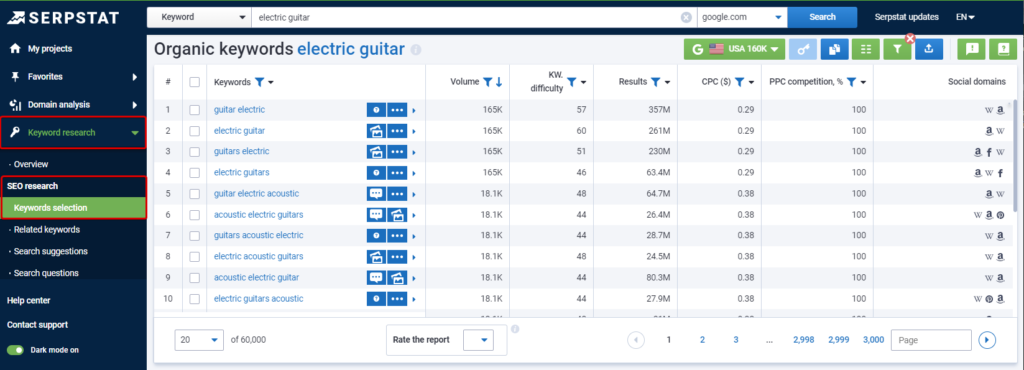
Ahrefs
Ahrefs is renowned for its extensive keyword database, which is one of the largest in the SEO industry. It goes beyond basic keyword suggestions by offering detailed metrics like keyword difficulty, search volume, and the estimated number of clicks. Ahrefs also excels in providing actionable insights, such as related keywords and questions that users are searching for, which can be instrumental in content strategy planning.
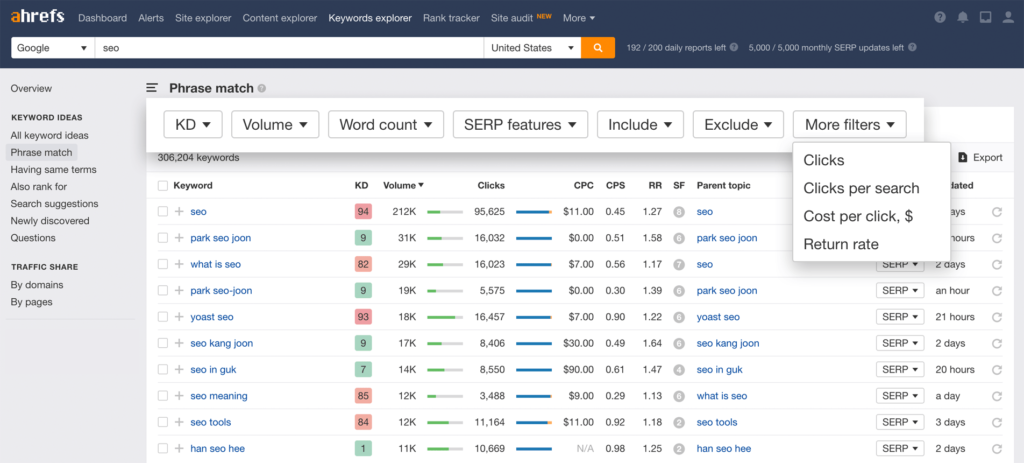
Comparative Analysis
When weighing Serpstat vs Ahrefs in terms of keyword research capabilities, both tools offer impressive features. Serpstat is particularly strong in trend analysis and user-friendliness, making it a great choice for those who need straightforward, insightful data. Ahrefs, with its vast keyword database and deep analytics, is ideal for users who require detailed, granular insights into keyword performance and competition.
Both tools provide filters to refine searches based on language, location, and search engine, allowing for tailored keyword research that suits different market needs. Additionally, they both offer features like exporting keyword lists and integrating with other tool functionalities, enhancing the overall SEO strategy development.
In conclusion, the choice between Serpstat and Ahrefs for keyword research will depend on your specific needs. If trend analysis and simplicity are your priorities, Serpstat is an excellent choice. For depth and breadth in keyword data, Ahrefs stands out as the more advanced option.
Backlink Analysis
Backlink analysis is a pivotal element of SEO strategy, and in comparing Serpstat vs Ahrefs, it’s essential to delve into how each tool performs in this aspect.
Serpstat
Serpstat provides a comprehensive backlink analysis tool that allows users to explore not just the quantity, but also the quality of backlinks. It offers insights into the authority of linking domains, the types of backlinks (do-follow vs no-follow), and the geographical distribution of backlinks. This information is crucial for understanding the strength and diversity of a website’s backlink profile. Moreover, Serpstat’s user-friendly interface makes it easy to track new and lost backlinks, a feature particularly useful for monitoring backlink health over time.
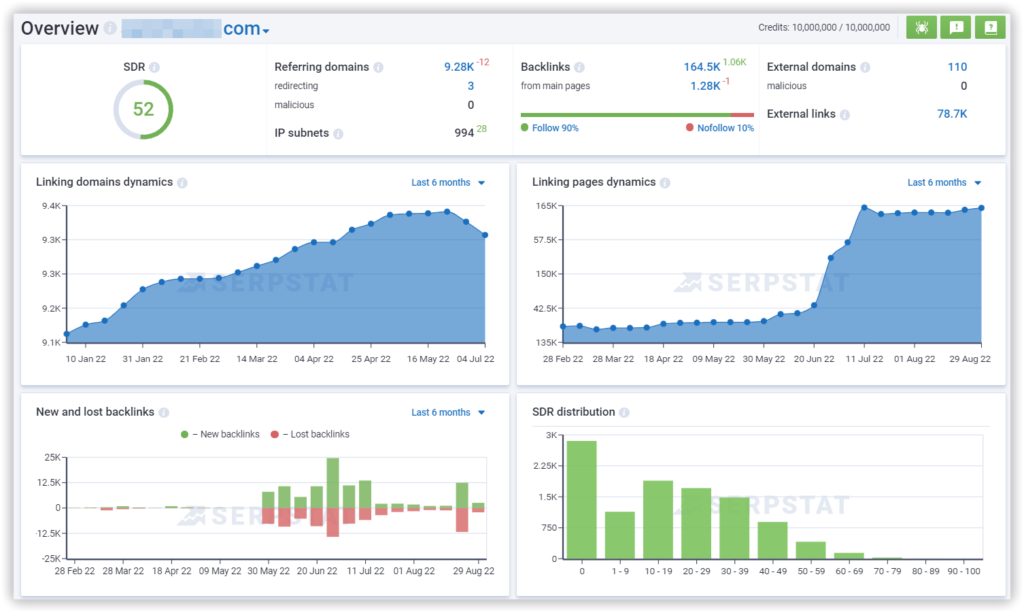
Ahrefs
Ahrefs is often regarded as one of the best tools for backlink analysis, thanks to its extensive backlink index. It provides detailed information about backlinks, including the anchor text used, the strength of the linking page, and the overall backlink growth or decline over time. Ahrefs also allows users to conduct a deep dive into competitors’ backlink profiles, offering valuable insights for competitive analysis and strategy development.
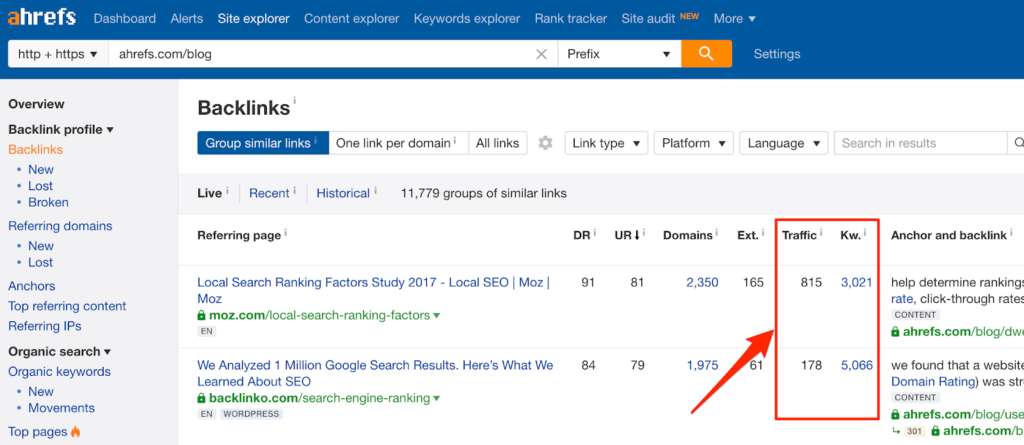
Comparative Analysis
In the realm of “Serpstat vs Ahrefs” for backlink analysis, both tools bring significant capabilities to the table. Serpstat stands out for its straightforward approach and ease of use, making it suitable for those who need quick and clear insights into their backlink profiles. Ahrefs, with its expansive backlink database and in-depth analysis tools, caters to users who require a more detailed and granular understanding of backlinks.
Both tools are equipped with functionalities like historical data viewing, which is essential for tracking the evolution of a backlink profile. They also provide actionable insights that can guide link-building strategies, such as identifying potential backlink opportunities based on competitors’ profiles.
Ultimately, the choice between Serpstat and Ahrefs for backlink analysis will depend on the depth of analysis you require and the complexity of the data you’re comfortable handling.
Competitor Analysis Features
Competitor analysis is a critical aspect of SEO and digital marketing. When considering Serpstat vs Ahrefs for this functionality, it’s important to evaluate how each tool aids in understanding and outperforming your competition.
Serpstat
Serpstat shines in its competitor analysis features by providing a comprehensive overview of competitors’ SEO strategies. It allows users to track competitors’ keyword rankings, discover their top-performing pages, and even analyze their ad campaigns. One of Serpstat’s standout features is its ability to identify market leaders in your niche, which can be invaluable for benchmarking and strategy development.
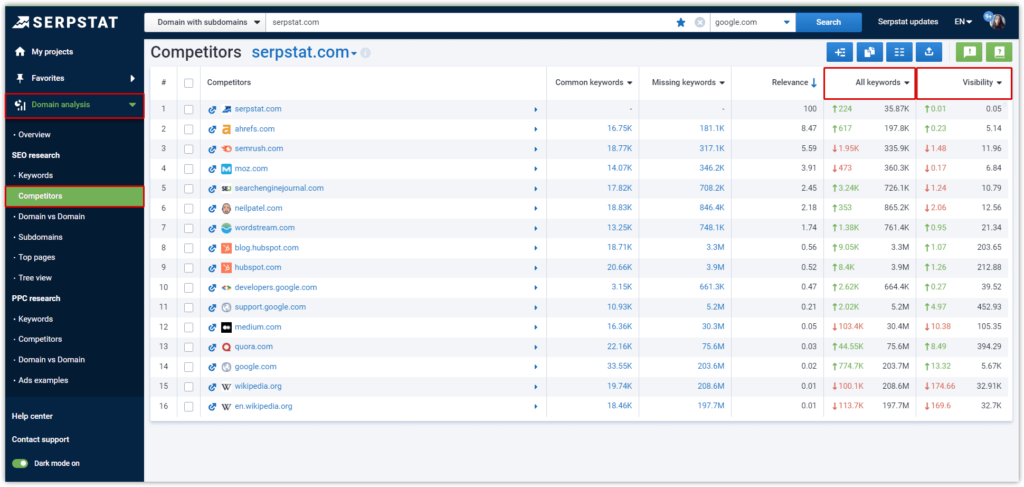
Ahrefs
Ahrefs offers a robust set of tools for competitor analysis. It excels in backlink analysis, enabling users to delve deep into their competitors’ backlink profiles and uncover new link-building opportunities. Ahrefs also provides detailed insights into competitors’ organic search traffic, keyword rankings, and content performance, giving a 360-degree view of their SEO strategy. The ability to see which pages and content types are driving the most traffic for competitors is especially useful for content strategy planning.
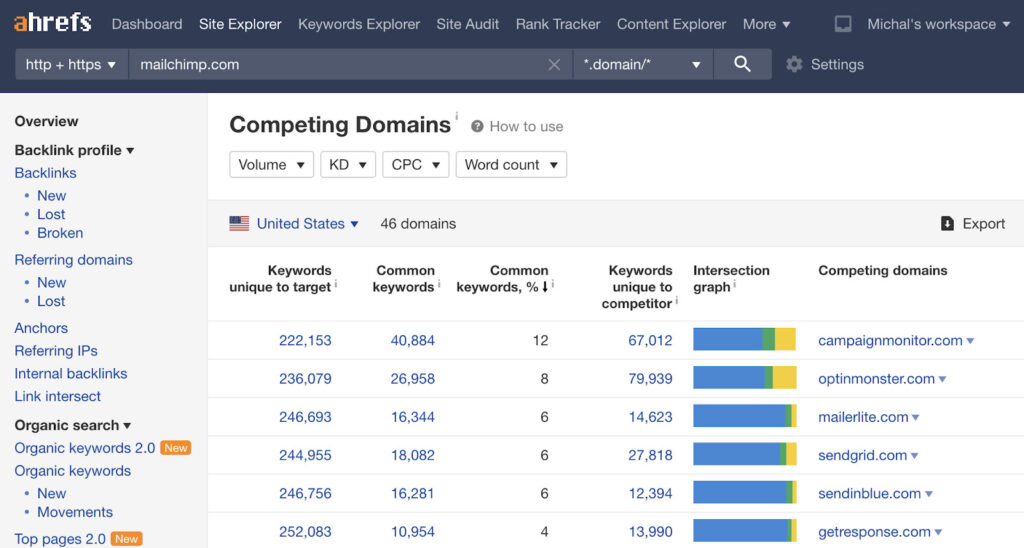
Comparative Analysis
In the debate of “Serpstat vs Ahrefs” for competitor analysis features, both tools offer significant strengths. Serpstat is particularly user-friendly and provides a quick overview of the competitive landscape, which is great for businesses that need straightforward, actionable insights. Ahrefs, with its detailed and granular data, is ideal for those who want to dive deep into every aspect of their competitors’ online presence.
While both tools provide essential data for understanding competitors, the choice between them will depend on the level of detail and the specific aspects of competitor analysis you are most interested in.
Site Audit Functionality
A thorough site audit is vital for identifying and rectifying issues that can affect a website’s performance in search engines. When comparing Serpstat vs Ahrefs in terms of site audit functionality, it’s essential to understand how each tool helps in pinpointing and solving SEO problems.
Serpstat
Serpstat’s site audit feature is designed to be comprehensive yet user-friendly. It swiftly scans your website for a wide range of issues such as broken links, HTML tag errors, and page load speed problems. The tool categorizes these issues into different levels of severity, making it easy for users to prioritize which problems to address first. Serpstat also provides detailed explanations and recommendations for each identified issue, which is particularly helpful for users who may not have extensive SEO expertise.

Ahrefs
Ahrefs offers a powerful site audit tool that crawls all the pages of your website, uncovering a multitude of technical and on-page SEO issues. It provides a health score for your site, which is a quick way to gauge overall SEO performance. Ahrefs is particularly detailed in its analysis, offering data on everything from internal link structures to social tags, and even JavaScript rendering issues. The tool also allows for scheduled audits, ensuring regular checks and updates on your website’s health.
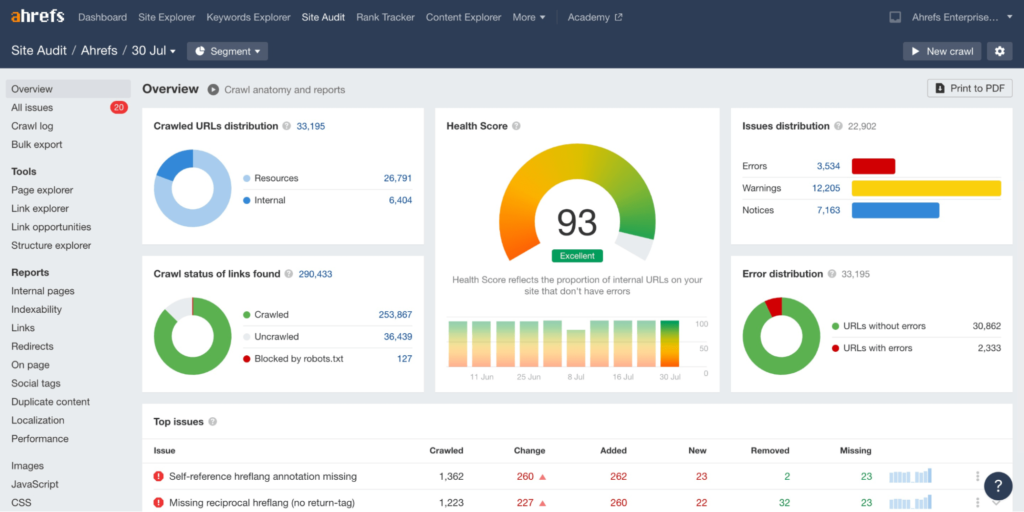
Comparative Analysis
In the context of “Serpstat vs Ahrefs” for site audit functionality, both tools offer robust solutions. Serpstat is advantageous for its ease of use and straightforward problem-solving recommendations, which are great for beginners or small businesses. Ahrefs, with its in-depth analysis and extensive crawling capabilities, is more suitable for larger websites or users who require a deeper dive into technical SEO issues.
While both tools effectively identify a wide range of SEO issues, the choice between them may depend on the complexity of your website and your level of SEO knowledge.
Content Marketing Tools
Content marketing is a key component of any SEO strategy. When evaluating Serpstat vs Ahrefs in the context of content marketing tools, it’s important to understand how each platform supports content creation and optimization efforts.
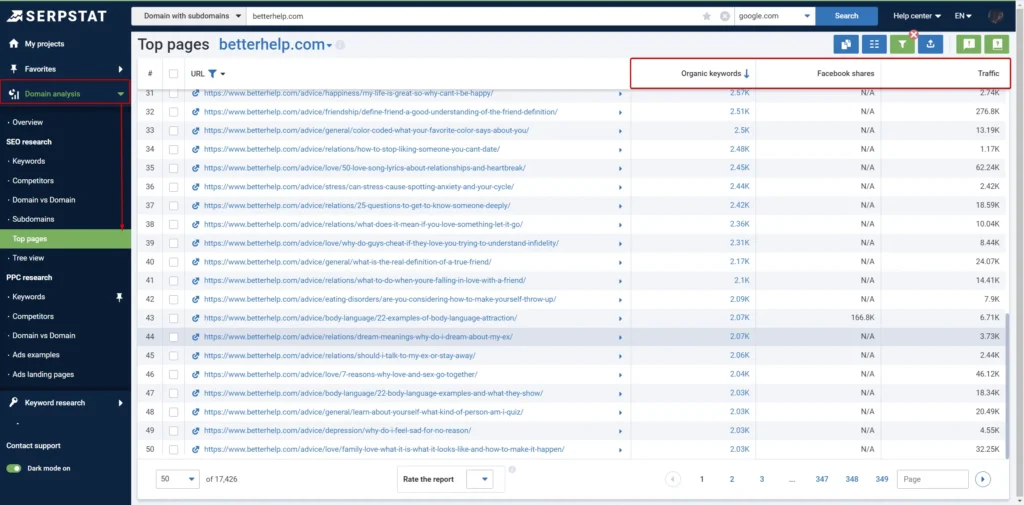
Serpstat
Serpstat offers a suite of tools that are particularly beneficial for content marketers. Its keyword research capabilities are invaluable for generating content ideas and understanding what topics are trending. Furthermore, Serpstat provides content analysis tools that help users optimize their content for specific keywords, ensuring that it’s not only relevant but also SEO-friendly. The platform also features a handy tool for checking the relevance and uniqueness of the content, which is essential in the age of content saturation.
Ahrefs
Ahrefs is renowned for its content explorer tool, which allows users to search for content on any topic and see which articles are performing the best in terms of social shares and organic search traffic. This feature is a goldmine for content marketers looking to understand what resonates with their audience. Additionally, Ahrefs provides detailed keyword insights, helping users to craft content that not only attracts but also retains user attention. Its ability to track content performance over time is another boon, offering insights into long-term content strategy effectiveness.
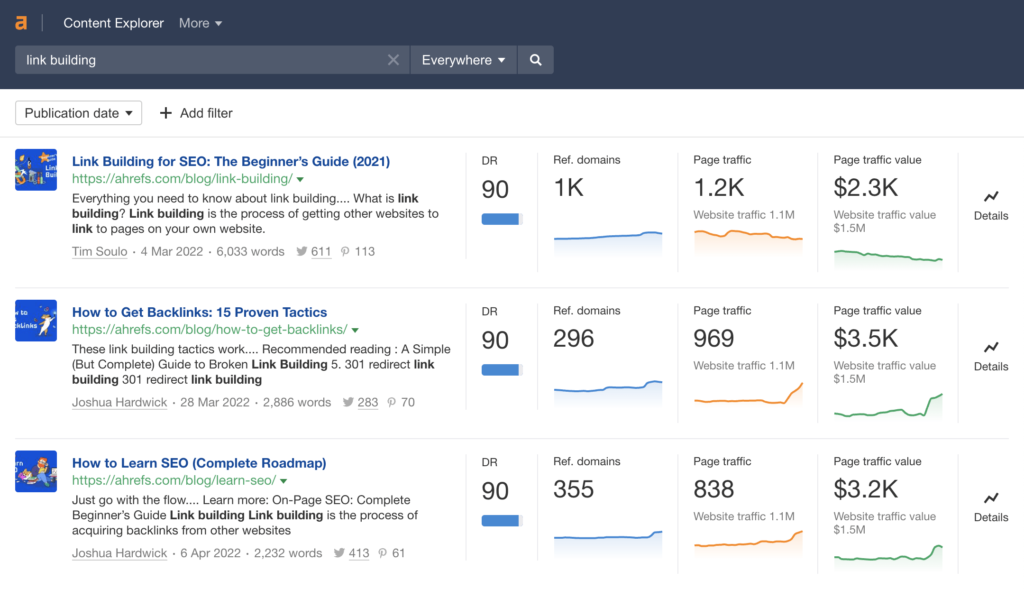
!image! (Here, showcasing Ahrefs’ content explorer with a focus on popular content and performance metrics would be informative.)
Comparative Analysis
In comparing Serpstat vs Ahrefs for content marketing tools, each platform brings unique strengths to the table. Serpstat is particularly user-friendly and great for ensuring content optimization and relevance. Ahrefs, with its comprehensive content explorer and performance tracking capabilities, is ideal for those who want to dive deep into content analysis and strategy refinement.
Both tools provide essential insights for content marketers, but the choice between them may hinge on whether you prioritize content optimization and uniqueness (Serpstat) or content discovery and performance analysis (Ahrefs).
Pricing and Plans
Understanding the pricing and plans is crucial when choosing between Serpstat and Ahrefs, as it directly impacts your budget and the features you can access. Here’s a breakdown of the pricing structures and plans of both tools, focusing on the “Serpstat vs Ahrefs” comparison.
Serpstat
Serpstat offers a tiered pricing structure, catering to a wide range of users from individual freelancers to large enterprises. The plans are typically divided into Lite, Standard, Advanced, and Enterprise, each escalating in features and user access limits. The Lite plan is suitable for beginners or small businesses, offering basic functionalities at an affordable price. As you move up the tiers, you gain access to more advanced features like historical data, extended limits, and API access, which are ideal for larger teams and agencies.
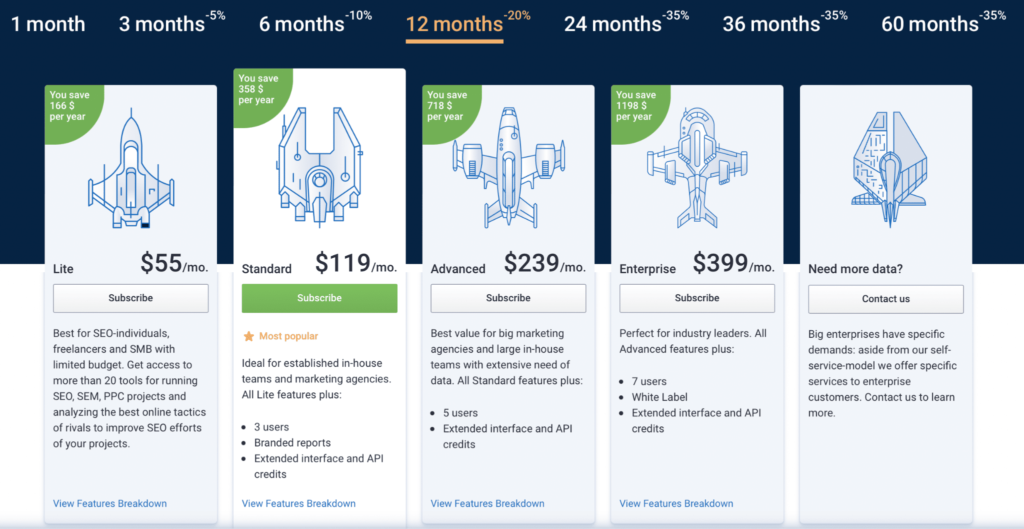
Ahrefs
Ahrefs also follows a tiered pricing model with plans named Lite, Standard, Advanced, and Agency. Each plan offers increasing levels of access to Ahrefs’ features, including keyword research, site audits, and competitor analysis. The Lite plan is a good starting point for individual users or small businesses, while the higher tiers are more suited to SEO professionals and agencies needing more comprehensive data and multiple user accounts. Ahrefs is known for its robust features, and even its lower-tier plans offer substantial value.
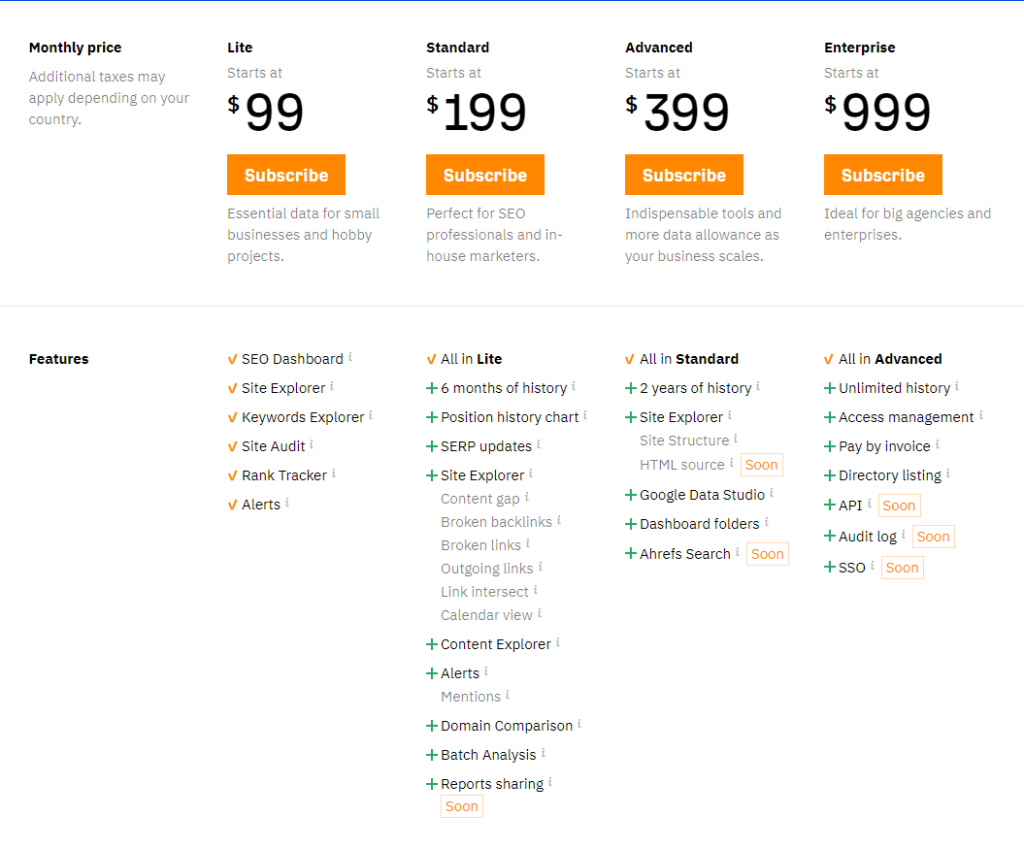
Comparative Analysis
When comparing the pricing and plans of Serpstat vs Ahrefs, both tools provide flexible options to suit different needs and budgets. Serpstat is generally more affordable, making it a good option for those with a limited budget or just starting out in SEO. Ahrefs, while on the pricier side, offers extensive features even in its lower-tier plans, which might justify the higher cost for users requiring more in-depth analysis.
Ultimately, the choice between Serpstat and Ahrefs in terms of pricing and plans will depend on your specific needs, budget, and the scale at which you plan to use the tool.
Reporting and Data Visualization
In the comparison of Serpstat vs Ahrefs, the capabilities in reporting and data visualization play a significant role, especially for professionals who rely on these tools for insights and strategic decision-making.
Serpstat
Serpstat offers efficient reporting tools that cater to both novice and advanced users. Its reports are straightforward and easy to comprehend, making it ideal for those who need quick insights without getting bogged down in excessive detail. The platform provides customizable reports, allowing users to choose which data points to include. This flexibility is beneficial for tailoring reports to specific audiences or objectives. Serpstat’s data visualization is clean and intuitive, with graphs and charts that clearly depict trends, comparisons, and other key metrics.
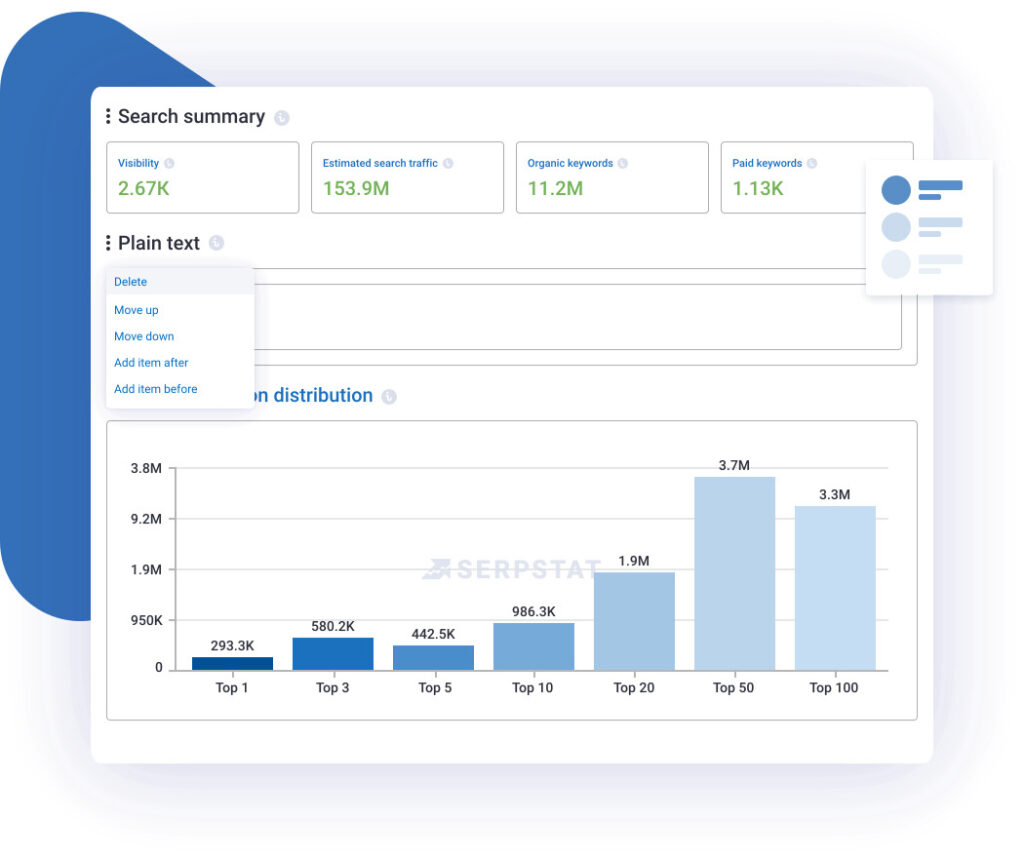
Ahrefs
Ahrefs excels in providing detailed and comprehensive reports. It offers a wide array of data visualization options, from detailed graphs and charts to advanced data segmentation. This level of detail is particularly useful for SEO professionals and marketers who need to dive deep into analytics. Ahrefs’ reports are highly customizable, and the platform allows for the export of data in various formats, which is handy for sharing insights with team members or clients.
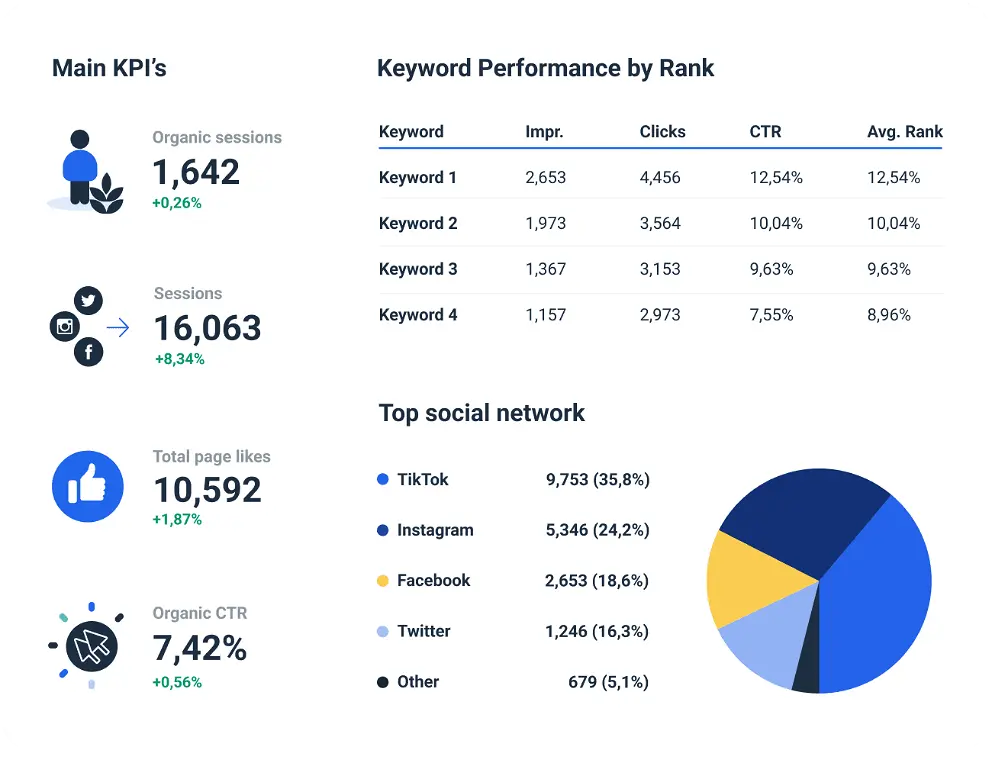
Comparative Analysis
In the “Serpstat vs Ahrefs” debate regarding reporting and data visualization, both platforms offer strong capabilities but cater to different user needs. Serpstat is more user-friendly and less overwhelming for those who prefer simplicity and ease of use. On the other hand, Ahrefs offers more in-depth and detailed reporting, which is ideal for users who require comprehensive data analysis.
Both tools provide the ability to customize reports, which is essential for focusing on metrics that matter most to your business or your clients.
The choice between Serpstat and Ahrefs for reporting and data visualization will largely depend on the level of detail you need and your proficiency in handling complex data.
Integration with Other Tools
The ability of SEO tools to integrate with other software is crucial for a seamless digital marketing workflow. In the comparison of Serpstat vs Ahrefs, understanding how each tool integrates with other platforms can be a deciding factor for many users.
Serpstat
Serpstat offers a decent range of integrations, particularly with analytics and data management tools. Its API is robust, allowing for the extraction of data which can be used in custom applications, dashboards, or integrated with other marketing tools. This is especially useful for businesses that rely on a tailored mix of software for their digital marketing needs. Serpstat’s integration capabilities enable users to streamline their SEO efforts with other aspects of their digital marketing strategy, such as PPC, content marketing, and social media analytics.
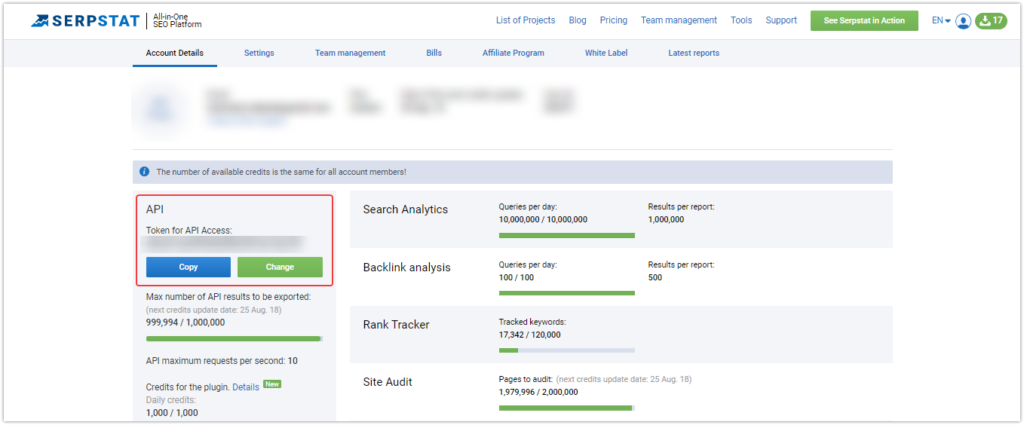
Ahrefs
Ahrefs has focused on developing a comprehensive standalone tool, and as such, its direct integrations with other platforms are limited. However, its powerful API provides the flexibility to export data and use it with various third-party tools and custom applications. For users who are comfortable with a more hands-on approach, Ahrefs’ API allows for extensive data manipulation and integration into broader marketing or analytics systems.
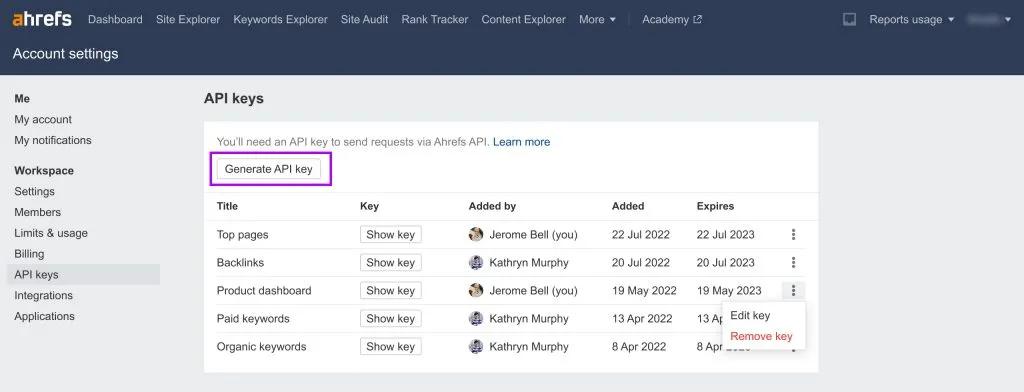
Comparative Analysis
In the context of “Serpstat vs Ahrefs” regarding integration with other tools, both platforms offer capabilities that cater to different user preferences. Serpstat provides more straightforward integrations, making it a good choice for users who need seamless compatibility with other digital marketing tools. Ahrefs, with its powerful API, caters to a more tech-savvy audience that requires extensive data manipulation and custom integration capabilities.
The decision between the two will depend on your specific integration needs and technical proficiency. If you require direct and easy integration, Serpstat might be more suitable. For those who need detailed data export capabilities for custom use, Ahrefs is the better choice.
Customer Support and Resources
The ability of SEO tools to integrate with other software is crucial for a seamless digital marketing workflow. In the comparison of Serpstat vs Ahrefs, understanding how each tool integrates with other platforms can be a deciding factor for many users.
Serpstat
Serpstat offers a decent range of integrations, particularly with analytics and data management tools. Its API is robust, allowing for the extraction of data which can be used in custom applications, dashboards, or integrated with other marketing tools. This is especially useful for businesses that rely on a tailored mix of software for their digital marketing needs. Serpstat’s integration capabilities enable users to streamline their SEO efforts with other aspects of their digital marketing strategy, such as PPC, content marketing, and social media analytics.

Ahrefs
Ahrefs has focused on developing a comprehensive standalone tool, and as such, its direct integrations with other platforms are limited. However, its powerful API provides the flexibility to export data and use it with various third-party tools and custom applications. For users who are comfortable with a more hands-on approach, Ahrefs’ API allows for extensive data manipulation and integration into broader marketing or analytics systems.
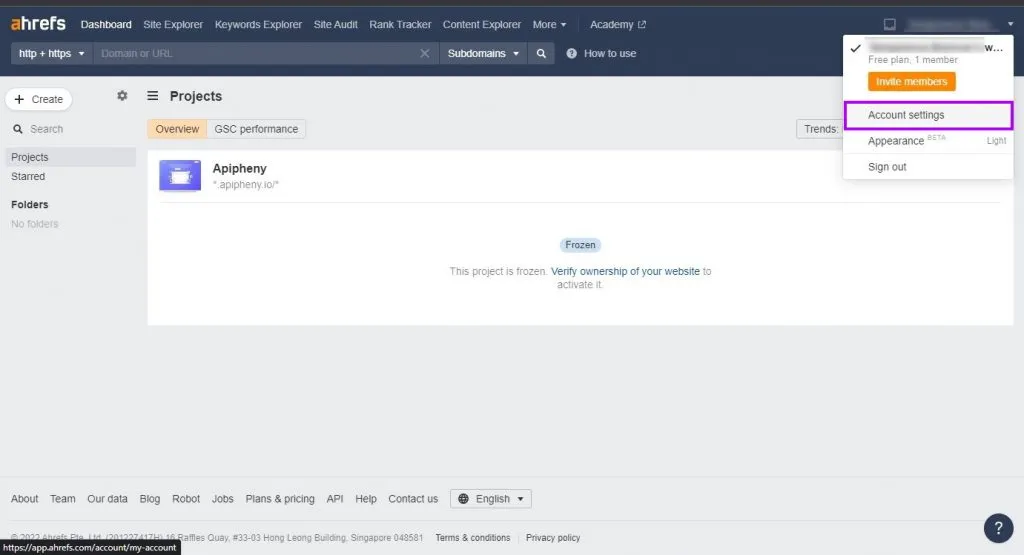
Comparative Analysis
In the context of “Serpstat vs Ahrefs” regarding integration with other tools, both platforms offer capabilities that cater to different user preferences. Serpstat provides more straightforward integrations, making it a good choice for users who need seamless compatibility with other digital marketing tools. Ahrefs, with its powerful API, caters to a more tech-savvy audience that requires extensive data manipulation and custom integration capabilities.
The decision between the two will depend on your specific integration needs and technical proficiency. If you require direct and easy integration, Serpstat might be more suitable. For those who need detailed data export capabilities for custom use, Ahrefs is the better choice.
Data Accuracy and Update Frequency
In the competitive world of SEO tools, data accuracy and update frequency are critical factors. When assessing Serpstat vs Ahrefs, it’s essential to understand how each tool ensures the reliability of its data and the regularity of its updates.
Serpstat
Serpstat places a high emphasis on data accuracy, which is essential for making informed SEO decisions. It regularly updates its database to reflect the latest changes in search engine algorithms and user behavior patterns. Users can expect frequent updates in keyword rankings, backlink data, and site audit results, ensuring that the insights they’re working with are current and relevant. However, the exact frequency of these updates can vary depending on the type of data and the specific plan a user has subscribed to.

Ahrefs
Ahrefs is known for its commitment to data accuracy and boasts one of the most frequently updated databases in the SEO tool market. It updates its keyword and backlink databases daily, giving users access to the latest data. This level of frequency is particularly advantageous for SEO professionals who need to stay on top of rapidly changing search trends and backlink profiles. Ahrefs’ commitment to data freshness ensures that users are making decisions based on the most current information available.
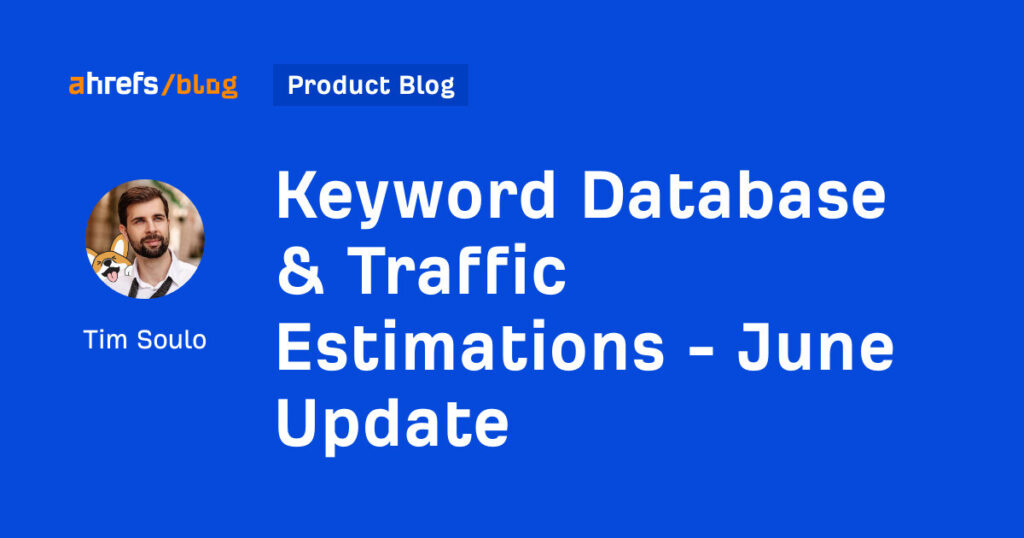
Comparative Analysis
In comparing Serpstat vs Ahrefs in terms of data accuracy and update frequency, both tools demonstrate a strong commitment to providing reliable and up-to-date information. Serpstat offers a balance of accuracy and update frequency suitable for most standard SEO needs. Ahrefs, with its daily updates, caters to those who require the most current data for their SEO strategies.
The choice between the two will depend on how critical the latest data is for your SEO activities. If daily updates are essential for your work, Ahrefs might be the better choice. If you’re looking for reliable data with regular updates that cater to a broad range of SEO tasks, Serpstat is a strong contender.
Mobile App Availability and Functionality
In today’s mobile-centric world, the availability and functionality of mobile apps for SEO tools are important considerations. When discussing Serpstat vs Ahrefs, it’s crucial to look at how each platform extends its services to mobile devices.
Serpstat
As of my last update, Serpstat did not offer a dedicated mobile app. Users looking to access Serpstat on mobile devices need to use its website through a mobile browser. While the website is responsive and adjusts to smaller screens, the experience is not as seamless and integrated as a dedicated mobile app would be. This could be a limitation for users who rely heavily on mobile devices for their SEO activities.
Ahrefs
Ahrefs, similarly, does not have a dedicated mobile app. Users have to access its features through a mobile browser. Like Serpstat, Ahrefs’ website is optimized for mobile use, ensuring that users can still access data and perform essential functions. However, the lack of a mobile app means that users might not get the full functionality or the ease of use that an app could provide.
Comparative Analysis
In the “Serpstat vs Ahrefs” comparison regarding mobile app availability and functionality, both platforms currently share the same limitation – the absence of a dedicated mobile application. For users who frequently work on mobile devices, this could be a significant factor in choosing an SEO tool. It’s important to consider how often you’ll need to access these tools on the go and whether a mobile-optimized website would suffice for your needs.
As the digital landscape continually evolves, there is always a possibility that either platform could develop a mobile app in the future, enhancing their accessibility and user experience.
For now, users of both Serpstat and Ahrefs need to rely on their mobile-friendly websites for on-the-go access, which, while functional, may not offer the full convenience of a dedicated app.
Community and User Base
The community and user base of an SEO tool can be a rich resource for learning, support, and networking. In evaluating Serpstat vs Ahrefs, it’s worthwhile to consider the size and engagement of their respective communities.
Serpstat
Serpstat has built a loyal and growing community, especially among small to medium-sized businesses and freelance SEO professionals. The platform offers a variety of resources like blogs, webinars, and case studies, fostering a learning environment for its users. Serpstat also maintains active social media channels and forums where users can share insights, ask questions, and get support. This sense of community is invaluable for users who are looking to stay informed about the latest SEO trends and best practices.

Ahrefs
Ahrefs boasts a large, diverse, and highly engaged user community, ranging from SEO beginners to industry experts. The platform is known for its extensive educational content, including a popular blog, detailed tutorials, and a YouTube channel with a wealth of instructional videos. Ahrefs’ community is active in online forums, social media groups, and at industry conferences, providing ample opportunities for networking and knowledge sharing. This extensive community support is a significant advantage, particularly for those looking to deepen their SEO expertise.

Comparative Analysis
When comparing Serpstat vs Ahrefs in terms of community and user base, both platforms offer vibrant communities, but they cater to slightly different audiences. Serpstat is particularly favored by small businesses and individual professionals, offering a supportive environment for those starting out or operating on a smaller scale. Ahrefs, with its larger and more diverse user base, provides a rich resource for users at all levels of SEO expertise, including access to some of the leading minds in the industry.
The choice between the two may depend on your preference for community size and the level of expertise you wish to engage with. Whether you’re looking for a close-knit community or a large network of SEO professionals, both Serpstat and Ahrefs offer valuable opportunities for growth and learning.
Unique Features and Innovations
In the comparison of Serpstat vs Ahrefs, each platform has unique features and innovations that set them apart. Understanding these can help you decide which tool better suits your specific SEO and digital marketing needs.
Serpstat
Serpstat distinguishes itself with several unique features. One notable innovation is its ‘Tree-View’ keyword tool, which provides a visual representation of keyword rankings and their changes over time. This feature is particularly useful for visualizing the SEO structure of your pages and understanding how different keywords perform. Additionally, Serpstat’s ‘Missing Keywords’ feature helps identify keywords that competitors rank for but your site does not, offering valuable insights for content strategy.
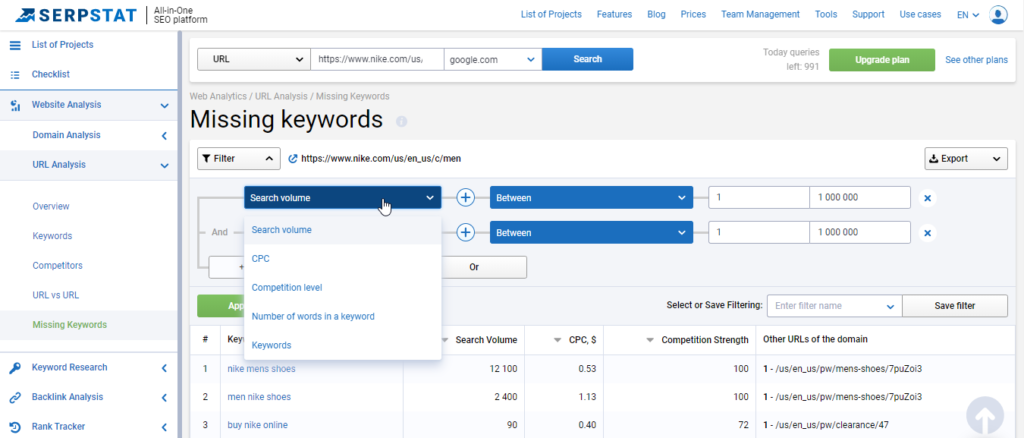
Ahrefs
Ahrefs stands out with its proprietary metrics like Domain Rating (DR) and URL Rating (UR), which are widely recognized in the SEO community for assessing the strength and quality of websites and backlinks. Another innovative feature is the ‘Content Gap’ analysis, which allows users to compare their content with competitors’ and identify gaps in their content strategy. Ahrefs also offers an extensive index for backlinks and a highly detailed ‘Content Explorer’ for uncovering the most successful content in any niche.
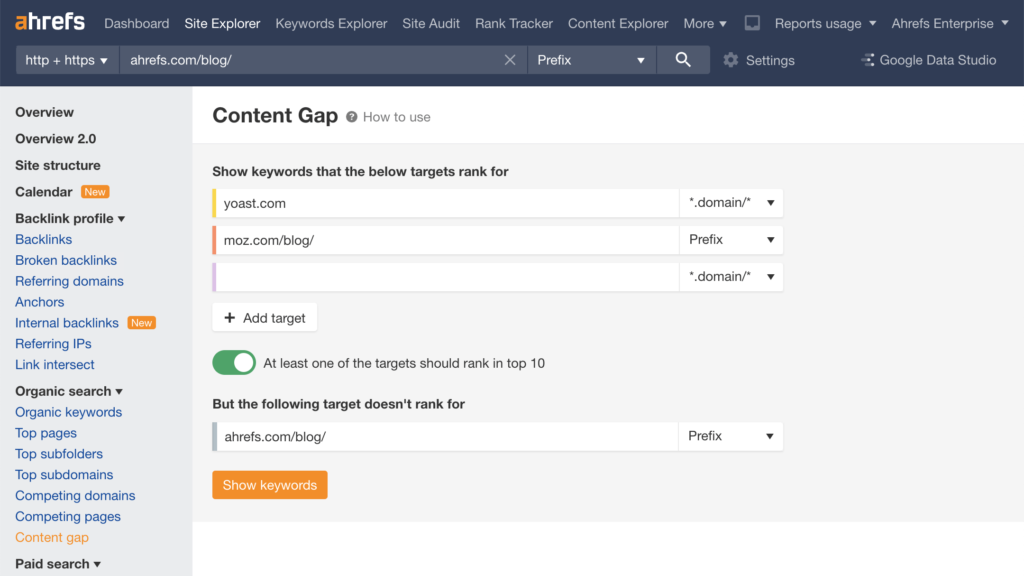
Comparative Analysis
In the “Serpstat vs Ahrefs” discussion regarding unique features and innovations, both tools offer distinct advantages. Serpstat’s Tree-View and Missing Keywords are excellent for those focusing on detailed keyword analysis and content opportunities. Ahrefs, with its proprietary metrics and comprehensive content and backlink tools, is ideal for in-depth website analysis and strategic content planning.
The decision between Serpstat and Ahrefs will depend on what aspects of SEO and content marketing you prioritize and the types of insights you need to drive your strategy.
Conclusion
In this comprehensive comparison of Serpstat vs Ahrefs, we’ve explored various aspects from ease of use to unique features, providing insights into what each tool offers. Both Serpstat and Ahrefs have their strengths and cater to different needs and preferences in the SEO and digital marketing realm.
Serpstat is a strong contender for those who value user-friendly interfaces, cost-effectiveness, and unique features like Tree-View keyword analysis. It’s particularly suited for small to medium-sized businesses, freelancers, and beginners in SEO who need a straightforward, affordable tool with solid functionality.
On the other hand, Ahrefs stands out with its extensive backlink database, detailed content analysis tools, and proprietary metrics like Domain Rating and Content Gap analysis. It’s a powerful option for SEO professionals, large agencies, and businesses that require in-depth analysis and detailed data for their strategies.
Ultimately, the choice between Serpstat and Ahrefs should be based on your specific needs, budget, and the scale of your SEO and content marketing efforts. Both tools offer excellent capabilities, but their suitability depends on your individual or organizational goals and how you plan to leverage SEO in your overall marketing strategy.
Remember, the best tool is not just about the number of features, but about how well it aligns with your objectives and how effectively you can use it to achieve your digital marketing goals.
